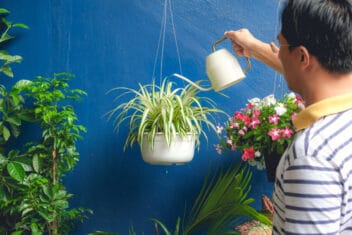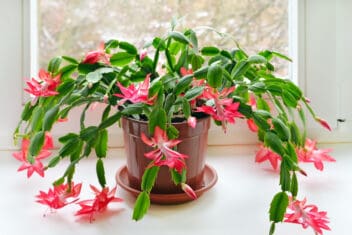Growing houseplants doesn’t need to be complicated. In fact, most of us prefer it be as easy as possible. That’s where plants like pothos come in. Known as devil’s vine, it’s a sturdy plant that gives the impression you’re an accomplished gardener.
Pothos suits any room whether you hang it in a basket or trail it along shelves. It comes in various shades and hues that look sleek and modern.
If you’re looking for an indoor plant that impresses but is easy-as-pie to grow, you can’t go wrong with pothos.
What is Pothos?

Pothos (Epipremnum arreum) is also called devil’s ivy or money plant. It’s a popular houseplant that’s native to French Polynesia, so it’s suited to warm and humid environments. It’s an evergreen vine with waxy leaves that suit all manner of indoor environments, especially in hanging baskets.
In the right climate, it can be planted outside where it grows large, but rarely flowers.
Pothos grows easily from cuttings and is a breeze to look after, so let’s explore this amazingly easy-to-grow and popular plant.
Varieties of Pothos
There are a lot of different varieties of pothos, so look around for different ones that suit your taste and décor. Here are some popular varieties:
Golden Pothos
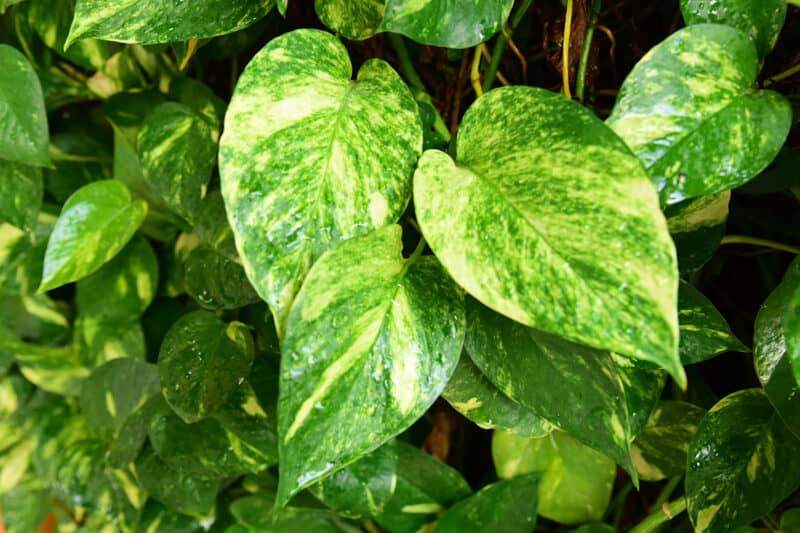
This is a classic cultivar perfect for the beginner. The leaves are heart-shaped with splashes of yellow or cream amongst mid-green hues. Outdoors, they can grow up to 40 feet long, but indoors they stay much smaller. They usually top out at 10 feet.
Marble Queen Pothos
Similar in size to golden pothos, the leaves are heart-shaped and streaked with creamy accents. ‘Marble Queen’ is another very common cultivar that you’ll often see at home stores and nurseries.
Glacier Pothos
This slow-growing variety has lovely green foliage with white accents mixed with silver and grey. I have this in a pot on my table right now, and it looks beautiful. It’s especially happy in bright rooms.
Cebu Blue
Cebu blue has longer, pointier leaves than some of the more common varieties. As it matures, the leaves develop fenestrations. The silvery-blue foliage looks amazing in a hanging basket.
Neon
This one really lives up to its name. ‘Neon’ has bright green leaves that seem to glow from within. As it ages, the leaves begin to turn darker. Keep it somewhere sunny for the best color since it becomes duller in shady areas.
Manjula
It’s hard to describe ‘Manjula,’ created by the University of Florida, because it is so exceptional. The heart-shaped leaves have a medium-green base with silver, cream, white, and light green mottling. It’s almost like the merle coloring you find on Australian Shepherds, only it’s a plant.
Satin Pothos
Sometimes called silver vine (Scindapsus pictus), this one isn’t a true pothos, but it looks similar and has the same growing requirements. We included it here because it’s usually sold as a pothos and it’s worth adding to your collection.
All pothos are perfect for growing in a hanging basket or a container with a moss pole they can climb, but this one is particularly suitable. The stems can grow up to 10 feet long with heart-shaped leaves covered in silver splotches.
How to Grow Pothos
Although you can grow pothos outside, unless you live in USDA Growing Zone 10 or above, it’s a good idea to keep them on a covered patio or balcony in movable pots. That way, you can rescue them if bad weather hits.
The ideal temperatures are 60ºF or above, so if your area never gets colder than that, feel free to plant them in the garden. Any lower temperature will either kill your pothos or make it struggle.
Indoors
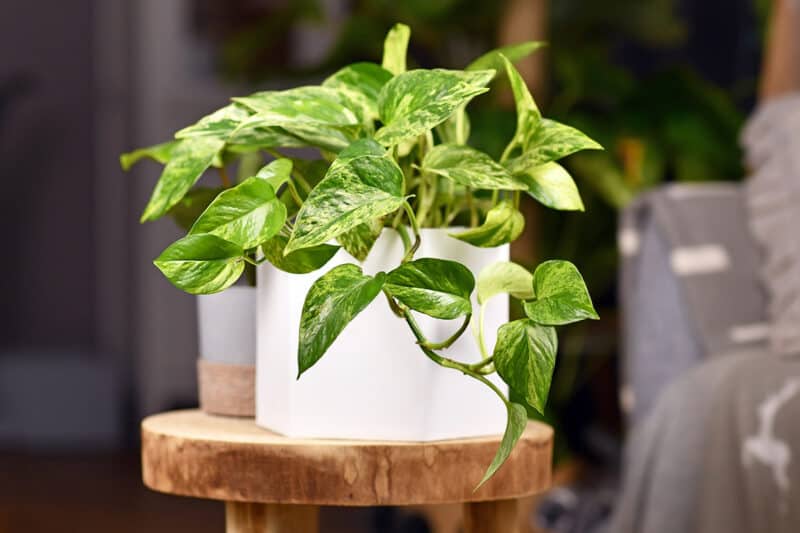
Indoors, pothos are perfectly happy in the same temperatures that you prefer – anything from 60°F and up.
Use a good quality potting mix that drains well. Pothos doesn’t like wet feet. These houseplants can be grown in standard containers or hanging baskets. Whichever you choose, be careful not to overwater and empty any catchment container an hour after watering.
Most varieties are long vines that can trail along shelves, mantels, or cupboards. You can also put a moss pole in a container to give them something to climb up.
Feed once every six months with a slow-release container fertilizer made for foliage plants. Only water when the top inch of potting mix becomes dry. The soil should be moist, but don’t soak the soil so that it’s pooling.
Remove any stems or leaves that are damaged, diseased, or turn yellow. This normally happens because the pothos has been hit by a child or pet, or the leaves are damaged by direct sunlight.
In Water
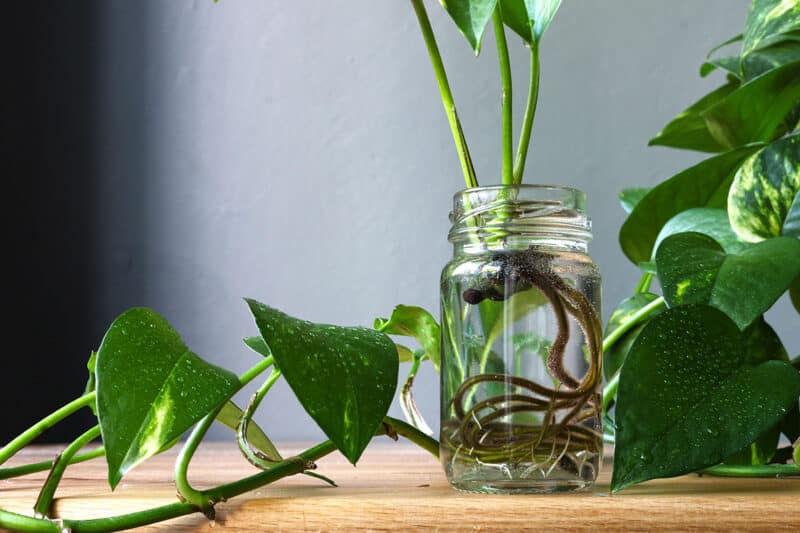
You can grow pothos in water – yes you read that right. If you choose a clear container, you can even watch the roots develop.
To get started, cut a length of healthy pothos vine. Make sure there are at least four or five leaf nodes on your cut piece.
Fill a clear vase or glass container with water. Preferably use water that’s not chlorinated, but if yours is, simply add the water a day or two before you put your plant in.
Place a couple of drops of liquid plant fertilizer in the water. Follow the instructions of your particular brand.
Remove the leaves of the vine that will be submerged as they will rot and contaminate the container.
Lower the vine into the water with the upper part draped over the edge of the container to keep it afloat.
Replace the water every two weeks or if it looks a little dirty. Add a couple of drops of liquid fertilizer each time and place the plant in indirect sunlight as direct is too hard on the leaves.
Keep the roots submerged and make sure to clean the vase each time you replace the water. You can lift the whole plant out to do this, so just be careful of the roots each time.
If your plant was originally growing in soil, it might need a few weeks to adjust to the aquatic life.
Outside
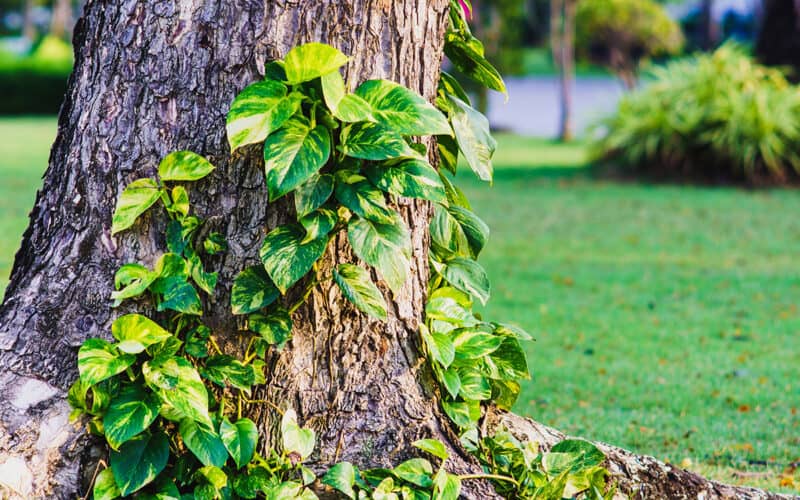
In its natural environment, pothos grows under the canopy of trees in humid forest environments, so try to recreate that. Plant in indirect sunlight at the base of a tree for the plant to trail up. You could also set up a trellis under a patio cover.
Pothos can reach up to 40 feet in length, so be prepared for that. I planted one outside and it grew out-of-control and nearly took over the canopy of the tree. I ended up having to remove it.
Aim for a soil pH of 6.1 to 6.5, but they are unfussy really unless the soil is too acidic – under 5.8 pH. Make sure the soil remains moist, but not soaking.
Remember that if your temperatures drop below 60ºF at any time, you should plant pothos in containers and move them to a warm location inside. Otherwise, provide them protection if you just have a night or two of unusually cold weather.
Although not a huge feeder, pothos can be fed with a balanced fertilizer every three weeks in spring and summer if it’s outside. Stop in winter to let it rest.
Propagating Pothos
Want to make more plants out of an existing one? Cut a length of vine about six inches long, making sure there are at least four or five leaves. Lower the vine into a jar of unchlorinated water and remove any leaves that are submerged. Change the water every few days.
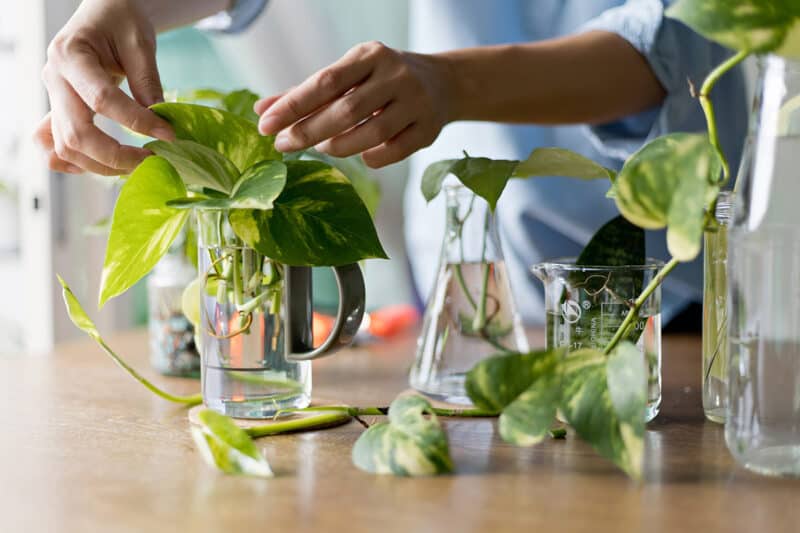
When roots form, remove and plant in a container with good quality potting mix. Don’t leave it in the water too long or the pothos will become accustomed to it and will struggle in soil.
You can also try dipping your fresh cutting in rooting hormone and plant in seed raising mix. Cover with plastic to keep the environment humid as it grows.
Common Problems and Solutions for Growing Pothos
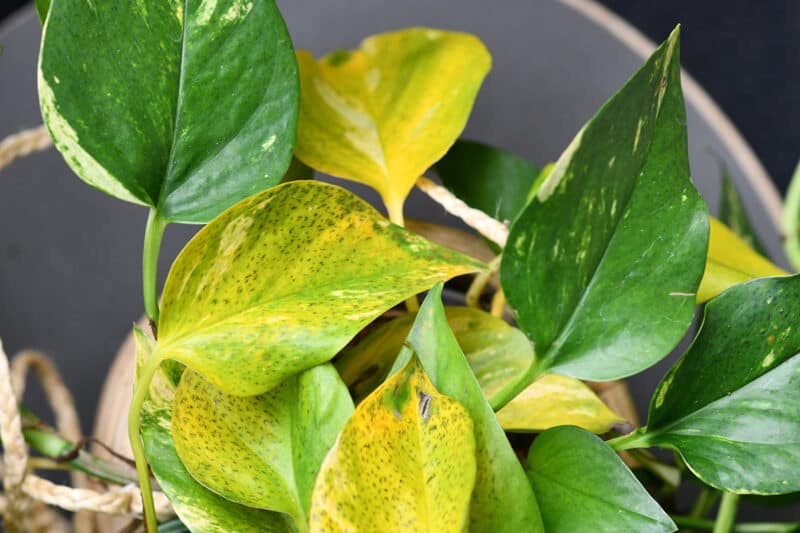
While pothos plants are normally quite hardy, they may occasionally suffer from the following pests and diseases:
Bacterial Leaf Spot
Caused by the bacterium Pseudomonas cochorii, this is usually avoided by watering the soil or potting mix, not the foliage.
You will see water spots on the leaves with yellow halos. In advanced infection, the centers of the spots can drop out of the leaves.
If this happens remove the infected parts of the plant, though you may need to destroy the whole thing.
Pythium Root Rot
This oomycete is common and lives in the soil, so only use fresh, sterile potting mix when you plant your pothos. If your plant starts to yellow despite good watering and fertilizing, Pythium root rot may be an issue. Mushy stems that blacken can also be a sign.
If you struggle with this issue often, when you first plant your pothos, you may want to give the leaves and roots a spray of a fungicide that is suitable for indoor houseplants.
Rhizoctonia Stem Rot
If your plant has this, you will see the stems rot at the soil level. This shouldn’t be an issue if you use clean potting mix. A copper fungicide helps if it does become a problem, but only if you catch it early on.
Scale
Scale isn’t a disease, it’s an insect. On houseplants, you often see scale on the stem and leaf joints. They are small lumps that don’t move, but suck the life out of your plant.
Separate the plant from your other indoor plants. Soak a cotton swab in rubbing alcohol and rub it on the scale. This works well in small numbers and when you don’t want toxic solutions inside your house.
You can also try mixing a teaspoon of mild liquid soap in a gallon of water and spraying it directly on the scale.
With both methods, you may have to gently pry the scale off the plant with a butter knife.
Mealybugs
Mealybugs look like little bits of lint on your plants and are quite common on houseplants. Don’t allow their presence to become an infestation.
Leaves often yellow and curl up at the edges when the bugs start to appear.
Use the rubbing alcohol method above, then mix neem oil with water and spray. You may want to do this in an area where the smell of the neem oil won’t annoy you, and you don’t need to use much.
There are insecticidal soaps available for indoor plants as well.
Regularly wipe the leaves of the pothos with a clean, slightly damp cloth.
Use Caution Around Pets
Pothos can be toxic to cats and other pets. Keep the plant away from your furry friends and you will have a wonderful, easy-to-please houseplant.

